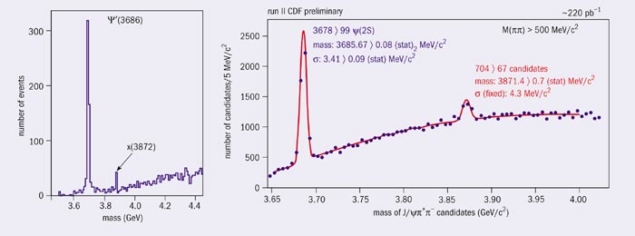
A new and unusual particle – the X(3872) – has been discovered by the Belle collaboration at the High Energy Accelerator Research Organization, KEK, in Tsukuba, Japan, and confirmed by an entirely different experiment, the Collider Detector at Fermilab (CDF), in the US.
Belle operates at KEK’s electron-positron collider, KEKB, which is designed to produce large numbers of B mesons at centre-of-mass energies around 10.58 GeV. While investigating the various ways that the B can decay, the Belle team found a small peak near 3.872 GeV in the mass plot for combinations of a J/Ψ with two π mesons – a little higher in energy than the large spike produced by the well known Ψ'(3686), which can decay to the same final state (Choi et al. 2003). This indicated the production of a new particle, which has been called the X(3872). Evidently the B can decay into an X and a K meson. The X(3872) then decays almost instantly into a J/Ψ and two π mesons.
Responding to these results, the CDF team quickly found the X(3872) in the rather different environment of 2 TeV proton-antiproton collisions at Fermilab’s Tevatron (Acosta et al. 2003). Their observation suggests that the X is produced not only in the weak decays of B mesons but also through the strong interaction, which dominates proton-antiproton interactions. The two observations are also nicely complementary. While Belle has found about 60 X events with little background, CDF has seen about 700 X events with a background of about 6000 events.
As its name implies, the X(3872) particle does not fit easily into any known particle scheme. Belle found the particle while looking for missing states of charmonium (bound states of a charm quark and antiquark), but the mass and decay properties of the X(3872) do not match theoretical expectations. As a result the X has attracted a considerable amount of attention from the world’s physics community, and theoretical physicists are considering a number of alternative explanations. These include the possibility that the X(3872) is a new type of exotic meson made from two quarks and two antiquarks – a multiquark “molecular state” of a D0 meson bound to an anti-D*0 – or a hybrid meson made from a charm quark and antiquark and a gluon.
Further reading
D Acosta et al. 2003 www.arxiv.org/hep-ex/0312021 hep-ex/0312021.
S-K Choi et al. 2003 Phys. Rev. Lett. 91 262001.







